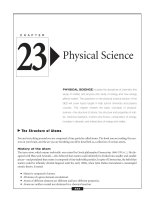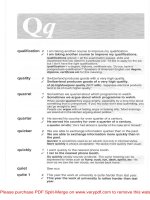2 8 matter (physical science)
Bạn đang xem bản rút gọn của tài liệu. Xem và tải ngay bản đầy đủ của tài liệu tại đây (2.55 MB, 14 trang )
Genre
Nonfiction
Comprehension Skill
Draw Conclusions
Text Features
• Captions
• Glossary
Science Content
Matter
Scott Foresman Science 2.8
ISBN 0-328-13791-X
ì<(sk$m)=bdhjbg< +^-Ä-U-Ä-U
Vocabulary
gas
liquid
mass
mixture
property
solid
states of matter
Picture Credits
Every effort has been made to secure permission and provide appropriate credit for photographic material.
The publisher deeply regrets any omission and pledges to correct errors called to its attention in subsequent editions.
Unless otherwise acknowledged, all photographs are the copyright © of Dorling Kindersley, a division of Pearson.
ISBN: 0-328-13791-X
Copyright © Pearson Education, Inc. All Rights Reserved. Printed in the United States of America.
This publication is protected by Copyright, and permission should be obtained from the publisher prior to any
prohibited reproduction, storage in a retrieval system, or transmission in any form by any means, electronic,
mechanical, photocopying, recording, or likewise. For information regarding permission(s), write to
Permissions Department, Scott Foresman, 1900 East Lake Avenue, Glenview, Illinois 60025.
3 4 5 6 7 8 9 10 V010 13 12 11 10 09 08 07 06 05
What did you learn?
1. What are some properties of matter
that you can observe by seeing?
2. How is a solid different from a gas?
by Kim Fields
3.
Water can
change from a gas into a liquid.
Write to explain how this happens.
Use the words water vapor, gas,
and liquid as you write.
4.
Draw Conclusions What could
you do to change milk into a solid?
Matter
All things are made of matter.
Matter has mass and takes up space.
Think about your bedroom. Your bed,
clothes, and toys are
made of matter.
2
Even things you cannot see are
made of matter. Air is a kind of matter.
3
All things made of matter have mass.
Mass is how much matter is in an object.
Matter is made of tiny parts. You can see
the tiny parts of matter through a microscope.
Properties
of Matter
Matter has different properties.
You can observe a property using
your senses. Some properties are
color, size, shape, and weight.
One property of matter is weight.
Which of these is light?
Which of these is heavy?
4
5
You can see and touch some
properties of matter.
Matter can feel smooth or rough.
This seashell feels smooth. Sandpaper
feels rough.
The seashell has a spiral shape.
The sandpaper is shaped like a square.
Another property of matter is size.
This beach ball is big. The golf ball is small.
Color is a property of matter. What colors
can you see on this beach ball?
6
7
States of Matter
You can measure the size of some
solids with a ruler.
The three states of matter are solid,
liquid, and gas.
Solids
A solid has its own shape and size.
A solid also has mass and takes up space.
A table is a solid. Your pencils and
erasers are also solids. They all have
a size, shape, and weight.
A notebook is made of solid matter. You
can find out how long, tall, and wide it is.
8
9
Liquids
A liquid is a kind of
matter without a shape.
A liquid takes the shape
of the container that
holds it. Liquids have
mass and take up space.
Milk is a liquid. It takes the shape of
the carton or jug that holds it. Pour milk into
a glass. Now it takes the shape of the glass.
A liquid can be measured using a measuring
cup. You can pour milk into a measuring cup
to find its volume. The amount of space a
liquid takes up is called its volume.
A measuring cup measures
the amount of space taken up
by a liquid.
10
11
The air you blow into
a balloon is made of gases.
You cannot see the gases.
They take up space, but they
have no shape of their own.
Gases
Gas is also a kind
of matter. Gas can
change size and shape.
Gas takes the size and
the shape of whatever
holds it. Gas also
has mass.
12
13
Matter can change in shape.
It can become round or square.
It can become flat or bumpy.
Changing Matter
There are many ways to change matter.
Matter can change in size.
It can get bigger or smaller.
The size of matter can
change. Take some bites
out of an apple. Now
the apple is a different size!
You can change dough
into many shapes.
14
15
Mixing and
Separating Matter
A mixture is something made of two or
more things. The things you put in a mixture
do not change.
These marbles are a mixture of colors.
The marbles are also a mixture of sizes.
You can separate a mixture
into its parts. Each marble
can be taken out one at a time.
You can separate the yellow marbles
from the green marbles.
16
17
Mixing with Water
Water is used to make
some mixtures. You can
separate these mixtures in
different ways. Put oil and
water together. The water
sinks and the oil floats.
Mix sugar and water.
If you heat this mixture,
the water can separate
by evaporating.
Oil floats on water.
18
Cooling Matter
Fruit juice is liquid matter. It can
change when you cool it. Pour juice
into molds. Put the molds into the freezer.
The juice in each mold will turn into
a frozen treat. Then it will be a solid.
Sugar mixes with water.
19
Water vapor from a kettle
touches cold glass and
changes into drops of water.
Water can also change from
a liquid to a solid. This liquid
rain changed to solid ice when
it got very cold.
Air contains water vapor. Water vapor is a gas.
Water vapor can change from a gas to a liquid.
When water vapor touches something cold,
it changes to liquid drops of water.
20
Rainwater drips from the roof and
freezes. It changes into solid ice.
21
Heating Matter
Heating can change a solid into a liquid.
Chocolate is a solid. When chocolate is
heated, it melts. Melted chocolate is a liquid.
22
Heating can change
a liquid into a gas.
When you light a candle,
the candle wax gets hot.
It melts and turns into
liquid wax.
The liquid wax gets
hotter and turns into
a gas. This is why
the candle gets smaller!
23
Vocabulary
Glossary
gas
liquid
mass
gas
matter that has mass and takes
mixture
the shape of its container
property
solid
liquid
matter that has mass and takes
states of matter
the shape of its container
mass
the amount of matter in
an object
mixture
two or more things with different
properties that can be separated
property
something about matter that you
can observe with your senses
solid
matter that has mass and
its own size and shape
Picture Credits
Every effort has been made to secure permission and provide appropriate credit for photographic material.
The publisher deeply regrets any omission and pledges to correct errors called to its attention in subsequent editions.
Unless otherwise acknowledged, all photographs are the copyright © of Dorling Kindersley, a division of Pearson.
states of matter the different forms matter can
take: solid, liquid, or gas
ISBN: 0-328-13791-X
Copyright © Pearson Education, Inc. All Rights Reserved. Printed in the United States of America.
This publication is protected by Copyright, and permission should be obtained from the publisher prior to any
prohibited reproduction, storage in a retrieval system, or transmission in any form by any means, electronic,
mechanical, photocopying, recording, or likewise. For information regarding permission(s), write to
Permissions Department, Scott Foresman, 1900 East Lake Avenue, Glenview, Illinois 60025.
24
3 4 5 6 7 8 9 10 V010 13 12 11 10 09 08 07 06 05
What did you learn?
1. What are some properties of matter
that you can observe by seeing?
2. How is a solid different from a gas?
3.
Water can
change from a gas into a liquid.
Write to explain how this happens.
Use the words water vapor, gas,
and liquid as you write.
4.
Draw Conclusions What could
you do to change milk into a solid?









